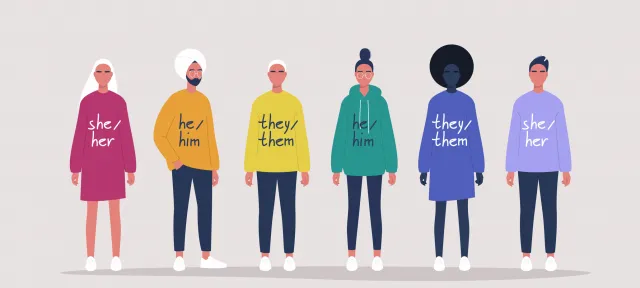The lesbian, gay, bisexual, transgender and queer (LGBTQ+) community has always existed and has played a quiet role in history. Social movements around the acceptance and rights of individuals who may identify with this group began as a response to persecution and discrimination for centuries. The LGBTQ+ community is a force to be reckoned with both in and out of the workplace. In a recent 2020 Gallup survey, over 5.5% of U.S. adults identify as LGBTQ+ which is greater than the 4.5% who self-identified in 2017.
Steps have been taken to promote greater equality within the workplace. In 2020, the U.S. Supreme Court ruled that a person can’t be fired due to their sexual orientation or gender identity under the Civil Rights Act of 1964. Even though this was a step in the right direction, there is still a lot that workplaces can do to promote a culture of diversity and acceptance.
In her latest T.R.U.E. Talk with Terri, “The LGBTQ+ Workforce is Here,” Diversity, Equity and Inclusion professional Terri Howard focuses on the LGBTQ community and how they can be supported in the workplace. She invited Jason Ray, president of the Wisconsin LGBTQ Chamber of Commerce, to contribute to this conversation. The T.R.U.E. series provides an opportunity to understand the different types of diversity and ask questions.
Why is this topic important?
Even though the LGBTQ+ community has a greater voice than in the past, there is still a lot of work. According to data from the Human Rights Campaign (HRC), 46% of LGBTQ employees don't come out in the workplace out of concern for their career or their workplace relationships. That is not the only reason that employees choose to stay closeted. One in five LGBTQ workers has reported being told or implied that they should dress more feminine or masculine at work. 53% of these workers also reported hearing jokes about lesbian or gay people at least occasionally at work. This means we have colleagues that are not even comfortable bringing their authentic selves to work or being openly targeted. 31% of LGBTQ+ employees within the workplace say they have felt unhappy or even depressed at work.
The good news is that many corporations and organizations are doing their part. Many have shown public gestures of support. They are increasingly making business decisions around recruitment, employee resource groups and marketing that embrace the LGBTQ+ population.
What can employers do to encourage employees to be themselves?
We want people to feel as though they can bring their best self to work. Making sure that the policies in place are inclusive of all individuals that include trans individuals in their policies is a step in the right direction. Forms should be inclusive and ask for pronouns. While dress codes are in place for professional use, dress should not be explicitly gendered as male or female.
“It's a journey when it comes to LGBTQ+ equality that isn't a simple three-step process,” said Jason Ray, “It's a continual journey that companies need to engage in to build a welcoming and inclusive environment where their employees can bring their best selves to their work.”
Even though we may be working from home, that does not mean that employees are isolated from the workplace. We still interact with employees and are authentically themselves in their work. Workplaces can use pride as the opportunity to reconnect with their employees and potentially identify gaps in their workplace.
What can employees do in the workplace?
We've talked about building the company culture but what can employees do as a colleague in the workplace to make folks feel included? First and foremost, make sure you're asking your colleagues what their pronouns are and then address them by those pronouns.
Make sure that you're using non-gendered language and not assume someone's gender identity just because of their appearance. Watching language is a simple way that we can do but has some of the biggest impacts. You should make sure that you and your coworkers are working to create that sense of inclusivity among themselves. You don’t have to conduct these big grand gestures and do grand things to make a difference.
Jason Ray encourages using the “platinum rule.” While the golden rule emphasizes treating others how you want to be treated, the platinum rule is about treating others as THEY want to be treated. The platinum rule forces you to get out of your comfort zone and place yourself in the shoes of someone else or purposefully ask questions.
How do I approach the topic to someone open in the workplace?
As in any relationship, asking questions depends a lot on the individual and their relationship with them. Regardless of your relationship status, be ready to do some reading and figure out what you want to know and understand. It is about just being vulnerable and admitting that you have questions. Saying, “I don't understand, can you help me?” goes a long way even though it sounds so simple.
A common misconception is that just because someone is LGBTQ+ in your organization, they are the “face” or the spokesperson for the entire community. While they may provide you with valuable personal insights, their experience may be unique to their situation and experience. Just like with race, you must avoid stereotypes and generalizations about the community.
Can I join an LGBTQ employee resource group if I don't belong to the community?
Even if you are not a member of the LGBTQ+ community, the community is always looking for supportive allies! For example, Jason Ray talks about opportunities at the Wisconsin LGBTQ Chamber of Commerce, “One of our programs is the LGBT Workplace Alliance which connects about 45 employee resource groups across Wisconsin. We've got several amazing allies who are part of those organizations who are helping to push for positive change within their company.”
No matter if you belong to an organization that explicitly supports LGBTQ+ rights, you can personally make a difference by individually actively building a more welcoming and inclusive space. We are a community all about acceptance and we welcome all allies to the table to be part of that movement towards full equality.
As an employer, what are some of the best practices for creating an inclusive workplace?
“There was a lot of talks after marriage equality came down about how and everyone has equal rights,” said Jason Ray, “However, there still is a long way to go until we have full equality for LGBTQ+ people and that includes in the workplace.”
Every organization has its policies surrounding LGBTQ+ support. Some ways to support LGBTQ+ employees include:
- Take LGBTQ+ discrimination seriously
- Promote allies of LGBTQ+ people
- Support the local LGBTQ+ community
- Make sure your policies are up to date with non-gendered language
- Look at your forms including pronouns and email signatures
- Offer or support LGBTQ+ employer business resource groups,
- Conduct marketing and outreach to the community by engaging with non-profit organizations.
There's a lot that companies can do to build that inclusive space.
In addition to these suggestions, leaders should take steps to make the workplace more comfortable. They should set a meaningful public example; they should refer to LGBTQ+ relationships in the same way they refer to other relationships.
LGBTQ+ Support isn’t Just for June!
It is important to be an ally every day and not just during pride month!
Terri Howard offers some suggestions for organizations.
“They should display visible symbols of support and encourage employees to do the same. Make your public commitment tangible possibly even financially and educate your team by not only setting an example but also providing resources.”
Learn More About Our Career Programs
* Bureau of Labor Statistics (BLS), U.S. Department of Labor, Occupational Employment and Wage Statistics 2023 / Occupational Outlook Handbook 2022. BLS estimates do not represent entry-level wages and/or salaries. Multiple factors, including prior experience, age, geography market in which you want to work and degree field, will affect career outcomes and earnings. Herzing neither represents that its graduates will earn the average salaries calculated by BLS for a particular job nor guarantees that graduation from its program will result in a job, promotion, salary increase or other career growth.





